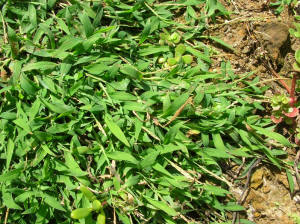|
 There are three main types of traps including the jaw type, the
plunger type, and the loop type. The plunger type is probably
least effective, since it is hardest to get set to the proper
depth. The folk remedy controls usually involve bubble gum or
juicy fruit gum in the runs, but these donít work consistently
enough to recommend them. Youíre better off chewing the gum
yourself while you are setting the traps. There are also poison
baits available that are effective. The soft baits, which are
meant to imitate grubs or worms, are effective. Poison peanuts
or milo are not effective, since moles donít eat seeds. There are three main types of traps including the jaw type, the
plunger type, and the loop type. The plunger type is probably
least effective, since it is hardest to get set to the proper
depth. The folk remedy controls usually involve bubble gum or
juicy fruit gum in the runs, but these donít work consistently
enough to recommend them. Youíre better off chewing the gum
yourself while you are setting the traps. There are also poison
baits available that are effective. The soft baits, which are
meant to imitate grubs or worms, are effective. Poison peanuts
or milo are not effective, since moles donít eat seeds.

Crabgrass Prevention

With the advanced development this spring because of
temperatures above normal, it looks like now is the time to
apply crabgrass preventative treatments. Normally the timing is
about April 1, but forsythia looks like it is ready to bloom
about two weeks early. Common pre-emergence chemicals include
benefin, benefin plus trifluralin, dithiopyr, pendimethalin, and
prodiamine. Due to the short-lived nature of the chemicals, a
second application will be needed in about six to eight weeks.
As a reminder, if you are seeding new grass, these applications
for crabgrass are not an option. The chemicals canít tell the
difference between weed seeds and what you put out.
Home Fruit Spray Schedules
It seems like quality fruit must be sprayed at the recommended
intervals. For apples and pears, we start with dormant oils,
these need to be applied before buds swell. Dormant oils are
usually needed only every two or three years to provide control
of scales and mites. Sure, the populations will build up in the
off years, but should remain relatively low if the three-year
program is followed. Superior oils are lighter grade oils which
wonít cause as much burn damage during late spring, or even
in-season, use. Superior oils will also provide control of the
mites and scales.
[to top of second column] |

The first regular spray of the year is applied when the green
tissue is Ĺ inch out of the bud. This spray for homeowners
usually consists of a multipurpose fruit spray (and sulfur if
needed for powdery mildew). Multipurpose fruit spray has been
re-formulated the last year or two to include malathion, captan,
and carbaryl (methoxychlor was eliminated from the old mixture).
This same mixture would be used when the fruit buds are in the
pink stage (when fruit buds show color).
After that, the persistence and consistence pays off as you spray
with the same mixture about every 10 days until we get to within
two weeks of harvest. In our area, we need to continue spraying
this late because of apple maggot and sooty blotch.
This spray schedule will also control borers on apples and pears,
if you also thoroughly spray the trunk and main limbs of the
trees. On non-bearing, young fruit trees where borers have
attacked, you can spray the trunks every two weeks during June
and July with a multipurpose fruit spray.

The spray schedule for peaches, nectarines, apricots, and plums
varies a little bit. The dormant spray for them uses captan
fungicide. This is the only spray that controls leaf curl and
plum pockets. The next spray is when fruit buds show color with
captan, followed by captan at bloom. When the husks begin to
pull away from the base of the fruit we would then spray with
sulfur, captan, and malathion. This mix would then be used every
10 days or so to within a week of harvest.
For borers on the peach group, you can spray or paint the trunk
only with carbaryl (Sevin) on June 15, July 15, and August 15.
We walk a tightrope with the loss of some of the insecticides
since carbaryl can cause fruit drop or thinning on the peach
group and some apples.
[By JOHN FULTON, COUNTY EXTENSION
DIRECTOR SERVING LOGAN, MENARD, AND SANGAMON COUNTIES] |